Visitor Info LGBT Scotland
Orkney
Add Neolithic Orkney: UNESCO World Heritage Site - (2 days)

Neolithic Orkney
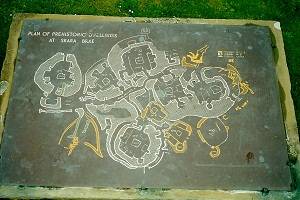
Skara Brae
(Skerrabrae)
One of the best preserved groups of prehistoric houses in Western Europe,part of the Heart of Neolithic Orkney World Heritage Site inhabited for around 600 years, between 3200BC and 2200BC which lay hidden for under the sand dunes for 4,000 years.
One of the best preserved groups of prehistoric houses in Western Europe,part of the Heart of Neolithic Orkney World Heritage Site inhabited for around 600 years, between 3200BC and 2200BC which lay hidden for under the sand dunes for 4,000 years.
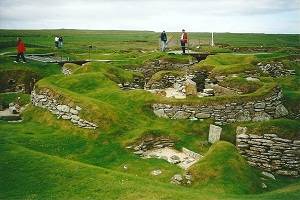
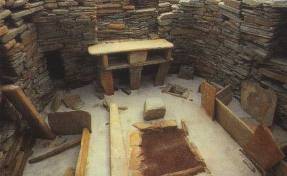
Maeshowe
is one of the finest architectural achievements of prehistoric Europe. Built over 5000 years ago, the mound is 35m in diameter and 7m high. The chambered cairn measures 4.5m square and about 4.5m in height, constructed using large dressed slabs carefully set together.
It was vandalised in the mid-twelfth century by Vikings who carved graffiti runes on the walls of the main chamber.
During winter solstice the setting sun shines directly down the passage of Maeshowe, illuminating the back wall and passage in a dramatic fashion for a few minutes. The sun then sets directly over the Barnhouse Stone.
It was vandalised in the mid-twelfth century by Vikings who carved graffiti runes on the walls of the main chamber.
During winter solstice the setting sun shines directly down the passage of Maeshowe, illuminating the back wall and passage in a dramatic fashion for a few minutes. The sun then sets directly over the Barnhouse Stone.
Sample Tour of Orkney
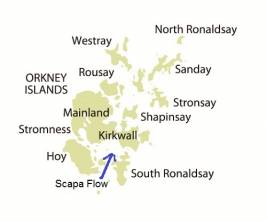
Stay overnight near Thurso and in the morning take the ferry to Stromness. Yes you can "do" Orkney in a day but that would be an injustice.
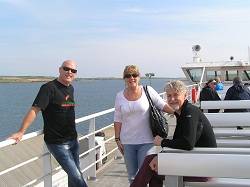
With an overnight stop in Kirkwall in the morning visit Scapa Flow, the Churchill Barriers and the Italian Chapel before taking the ferry from South Ronaldsay back to the mainland.
Standing Stones of Stenness
The stones are thin slabs, approximately 300mm thick. Four, up to about 5m high, were originally elements of a stone circle of 12 stones, laid out in an ellipse about 32m diameter on a levelled platform surrounded by a ditch.
The ditch is cut into rock by as much as 2m depth and is 7m wide, surrounded by an earth bank, with a single entrance causeway on the north side. Erected around 3000BC.
The Tomb of the Eagles
A unique 'hands-on' experience, where you can see, and enjoy the privilege of handling some of the original artefacts found at the sites. During the main visitor season, fascinating displays and daily talks offer insights into the lives of these Stone Age and Bronze Age people.
Standing Stones of Stenness
The stones are thin slabs, approximately 300mm thick. Four, up to about 5m high, were originally elements of a stone circle of 12 stones, laid out in an ellipse about 32m diameter on a levelled platform surrounded by a ditch.
The ditch is cut into rock by as much as 2m depth and is 7m wide, surrounded by an earth bank, with a single entrance causeway on the north side. Erected around 3000BC.
The Tomb of the Eagles
A unique 'hands-on' experience, where you can see, and enjoy the privilege of handling some of the original artefacts found at the sites. During the main visitor season, fascinating displays and daily talks offer insights into the lives of these Stone Age and Bronze Age people.
Wartime Orkey
Scapa Flow
is the large natural sheltered anchorage that became the main British naval base for the Royal Navy in both World Wars.
It was here that the German Fleet was interred after WWI pending the outcome of the Versailles Treaty However the Germans managed to scuttle 52 of the 74 ships in 1919 to prevent them being used by the Allies.
Although most of the fleet was salvaged in the 20's and 30's seven ships still remain and are popular with scuba divers.
In WW2 the British fleet were again based in Scapa Flow but there were concerns from U-boat attacks. The Royal Oak was torpedoed and sunk in 1939 with the loss of 833 men. As a war grave diving is forbidden
As a result the "Churchill Barriers" were built, a series of causeways to block the eastern approaches to Scapa Flow; they were built by Italian prisoners of war held in Orkney. These "Churchill Barriers" now provide road access from the mainland to Burray and South Ronaldsay.
The Italian Chapel is all that is left of the POW camp for Italian prisoners. The POW's converted two old Nissen Huts into a chapel using unwanted scrap and some concrete.
It was here that the German Fleet was interred after WWI pending the outcome of the Versailles Treaty However the Germans managed to scuttle 52 of the 74 ships in 1919 to prevent them being used by the Allies.
Although most of the fleet was salvaged in the 20's and 30's seven ships still remain and are popular with scuba divers.
In WW2 the British fleet were again based in Scapa Flow but there were concerns from U-boat attacks. The Royal Oak was torpedoed and sunk in 1939 with the loss of 833 men. As a war grave diving is forbidden
As a result the "Churchill Barriers" were built, a series of causeways to block the eastern approaches to Scapa Flow; they were built by Italian prisoners of war held in Orkney. These "Churchill Barriers" now provide road access from the mainland to Burray and South Ronaldsay.
The Italian Chapel is all that is left of the POW camp for Italian prisoners. The POW's converted two old Nissen Huts into a chapel using unwanted scrap and some concrete.
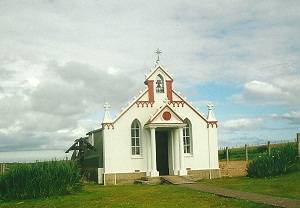
The Italian Chapel is open to the public all year round, and is one of Orkney's most visited sites.

Kirkwall makes an excellent base to tour Orkney
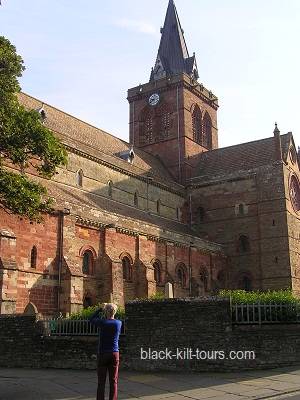
St Magnus Cathedral

Kirkwall. Orkney
<< home page
Copyright © Black Kilt Tours 2011-2021 All rights reserved. All images are the property of Black Kilt Tours or used under licence